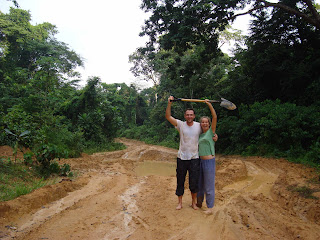


After our epic journey through the mud we headed down to Limbe on the coast to relax for a couple of days. The country in beautiful with a thick cover of rainforest. It rains fairly relentlessly at this time of year, but when the sun comes out it is all worth it.
We are now in Yaounde, the capital. We have fixed our car. Our mud adventure had written off the brakes and we needed to replace all our filters. We have also ripped a piece off the side of the car but its only cosmetic. Later today we head down to the Gabonese border, after which we cross into Congo, DRC and then Angola. We met a South African couple coming north who have given us all the info we need to get down to Namibia without straying into bandit territory or getting stuck on terrible roads (or, as they did, both at the same time!). We feel confident about the rest of the trip south, although securing visas for DRC and Angola may be a little tricky.





































